Posts Tagged ‘Nymphs’
{{start}}
The word nymph has of course two fly fishing meanings. The first is “Juvenile, sexually immature stage of certain insects, usually similar to the adult in form, and which require an intermediate stage before becoming an adult. Mayflies, Caddis flies, Dragonflies, Damselflies, Stone flies and Midges are all insects that spend part of their life cycle in the water and have a nymph stage.” The second is flies tied to imitate the first i.e. “the nymphal stage of an insects life cycle”. I have narrowed down the selection of nymphs that I carry to just the list below.
{{end}}
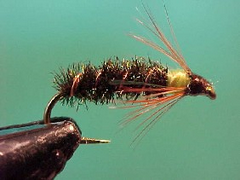
{{+1}}Stick fly{{-1}}
{{start}}
There are more versions of stick flies than you can poke a stick at (excuse the pun) and this one is a compilation of a couple that I like. Its easy to tie and works well particularly early in the season when the water is just starting to warm up and there isn't that much food about.{{end}}
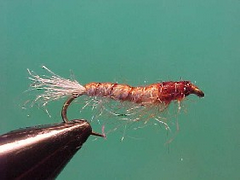
{{+1}}Free swimming caddis{{-1}}
{{start}}
The third group are the free swimming caddis grubs. These caddis grubs move amongst the detritus matter and the rocks foraging for food and partners and of course drift in the current assuming the fetal position or free swim in the current as they migrate down stream.{{end}}

{{+1}}Czech nymphs{{-1}}
{{start}}
The uncased caddis have quite a few similarities. They often adopt a curved fetal position and when they are free swimming they are more elongated still with a curved back but with a lifted head. The have short tail like filaments, have bodies of around seven or eight segments that may have abdominal gills at each segment, have darker heads with two or three segments and have 3 or more sets of legs below the head or toward the front of the grub.{{end}}
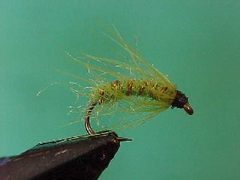
{{+1}}Fuzzy spiders – Chatto’s original{{-1}}
{{start}}
There is almost no limit to the combinations that you can come up with and these are the ones that I regularly fish and you may like to try. I don't know if fish pick them up as emerging insects but they do fish well when fish have emergers on the menu.{{end}}
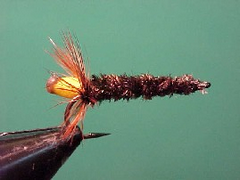
{{+1}}Stick caddis – Chatto’s tie{{-1}}
{{start}}
This is the lava of a Caddis fly (or Sedge) and is common from September through to December particularly in the flooded margins of lakes. Can be fished relatively static as a prospecting fly with a very slow retrieve or used as an ambush fly when polaroiding.{{end}}
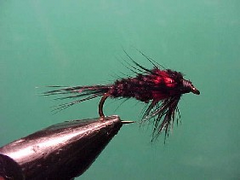
{{+1}}Montana nymph{{-1}}
{{start}}
The Montana nymph was developed in the earlier days of fly fishing in Montana America as an imitation for a stonefly. It has two distinct uses. The first is as a bait fly when fished behind a bead head nymph in faster rivers and streams. The second use is as as a middle dropper fly in a team of lock style flies in still water where the the flash of red, yellow, orange or pink in the thorax it make it a great attractor pattern.{{end}}
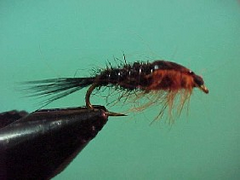
{{+1}}Montana nymph – Chatto’s variant{{-1}}
{{start}}
I carry this fly in my lake box rather than my nymph box because I use it in lakes rather than rivers. For me it is a great middle dropper fly in a team of lock style flies in still water where the the flash of red, yellow, orange or pink in the thorax it make it a great attractor pattern.{{end}}
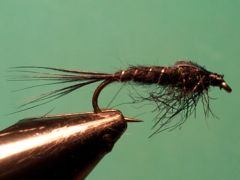
{{+1}}Flash back fuzzy nymph{{-1}}
{{start}}
In fast flowing water or where you just want your nymph to stand out a little a Flash Back nymph is an option. Whilst this nymph is not tied to represent the nymphal (sub imago or pupa) stage of any specific insect it is a good “buggy” looking fly and readily accepted by trout.{{end}}
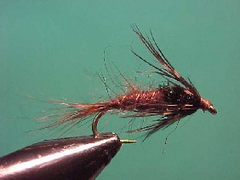
{{+1}}Cruncher{{-1}}
{{start}}
When it all boils down the "Cruncher" isn't that different to so many nymphs that you see but it does have a trigger point in the form of the front hackle and of course as you would expect it does catch fish. I tend to carry it only in size 10 and size 12 and use it when a big buggy nymph is called for in river fishing, loch style fishing or even when polaroiding.{{end}}

{{+1}}Pheasant tail nymph variant{{-1}}
{{start}}
The fly that Frank sawyer created was not representational of any particular mayfly nymph but rather is suggestive of the broad range of nymphs that he came across in his duties and his recreational fishing. I tie olive, brown and claret versions of this fly in a couple of sizes. These pheasant tail variants make up around 20% of the content of my nymph fly box and account for probably 80% of the trout I catch on nymphs.{{end}}













